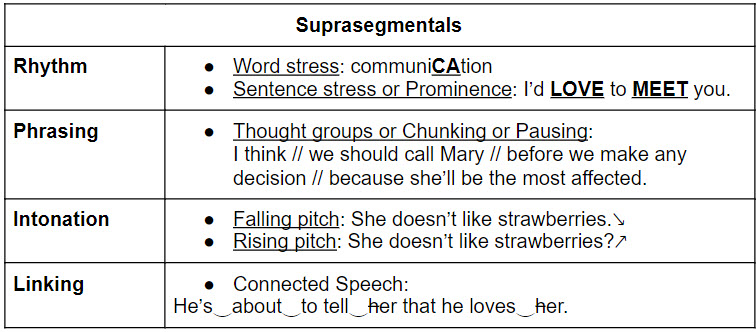by Ana Paula Biazon Rocha
L2 pronunciation teaching and learning involves the consideration of segmental and suprasegmental features and how they affect the intelligibility, comprehensibility and accentedness of one’s speech, according to the context where it is produced, such as ESL, EFL, ESOL or ELF.
If you had to read the definition above at least twice, felt a bit uneasy and are still not sure what it means, no worries, you are not alone! Sometimes we teachers feel overwhelmed by the amount of abbreviations, keywords and concepts we are supposed to know by heart. Many of them are confusing and, let’s be honest, we are not walking dictionaries! Thus, in this post, we will revise some of the essential terms and definitions in L2 pronunciation teaching and learning, so we can understand and feel more confident when using them.
First, the features of English pronunciation are mainly divided into:
- segmentals: the vowels and consonant sounds of the language (Derwing & Munro, 2015). Click here to check and download Mark Hancock’s PronPack Sound Charts.
- suprasegmentals: elements that go beyond the individual sounds, such as rhythm, phrasing, intonation, and linking. Suprasegmentals are also known as prosody, so suprasegmental features are the same as prosodic features (Derwing & Munro, 2015).

Other important features are:
- global features: voice quality, volume and speech rate (Grant, 2014).
- incidental features: paralinguistic or non-verbal features such as gestures, body language and eye contact (Grant, 2014).
Secondly, L2 pronunciation teaching and learning are based on three pivotal concepts (Derwing & Munro, 2015):
- intelligibility: the extent to which the listener can actually understand the message that the speaker is trying to convey. In other words, how much we can understand and be understood when speaking English.
- comprehensibility: how easy or difficult it is for the listener to understand the speaker’s utterance.
- accentedness: how different the standards of one’s pronunciation is perceived by members of other speech communities. It’s always important to keep in mind that ‘a particular utterance could be heavily accented and yet be fully intelligible’ (p. 05).
Third, the way we teach and learn L2 pronunciation is highly influenced by the context we are in. For example:
- If you teach ESL, English as a Second Language, you may draw your students’ attention to perceiving and understanding native accent because they will probably be communicating with native speakers on a regular basis.
- If you teach EFL, English as a Foreign Language, you may want to focus on difficulties that speakers of the place you are teaching in have when speaking English. For instance, when teaching English in Brazil, I used to discuss with my learners common pronunciation problems of Brazilian speakers, and make comparisons and distinctions between the sound systems of English and Brazilian Portuguese.
- If you teach ESOL, English for Speakers of Other Languages, you do a bit of both, ESL and EFL, so you may concentrate on functional language, or survival English, as students need to improve their skills to survive in an English-speaking country. Click here for more information.
- If your context is ELF, English as a Lingua Franca, your students are used to interacting with other non-native speakers of the language and need to focus on specific pronunciation features such as word stress, intonation, consonant clusters, and others, to understand and be understood in this setting. For more information on ELF, Jenkins (2000) should be your main source.
Finally, it is imperative to consider that students do not learn L2 pronunciation incidentally. Research has proven that pronunciation instruction is effective and helps learners improve their perception and production of the language (Derwing & Munro, 2015; Grant, 2014). Therefore, as mentioned several times in previous blog posts, which can be accessed here, pronunciation should be taught in every lesson and in everything we do in the face-to-face or online classroom. Students cannot produce what they cannot perceive, and they need help to perceive pronunciation features. Hopefully, now that we teachers know more about the terms and definitions on which L2 pronunciation teaching and learning are based, we can feel more prepared and motivated to always include pronunciation in our teaching practices.
Don’t forget to leave your comment below and follow PronSIG on social media.
References
Derwing, T., & Munro, M. (2015). Pronunciation fundamentals: Evidence-based perspectives for L2 teaching and research. Amsterdam, the Netherlands: John Benjamins.
Grant, L. (2014). Pronunciation Myths. Applying Second Language Research to Classroom Teaching. Ann Arbor: The University of Michigan Press.
Jenkins, J. (2000). The Phonology of English as an International Language. Oxford: Oxford University Press.


